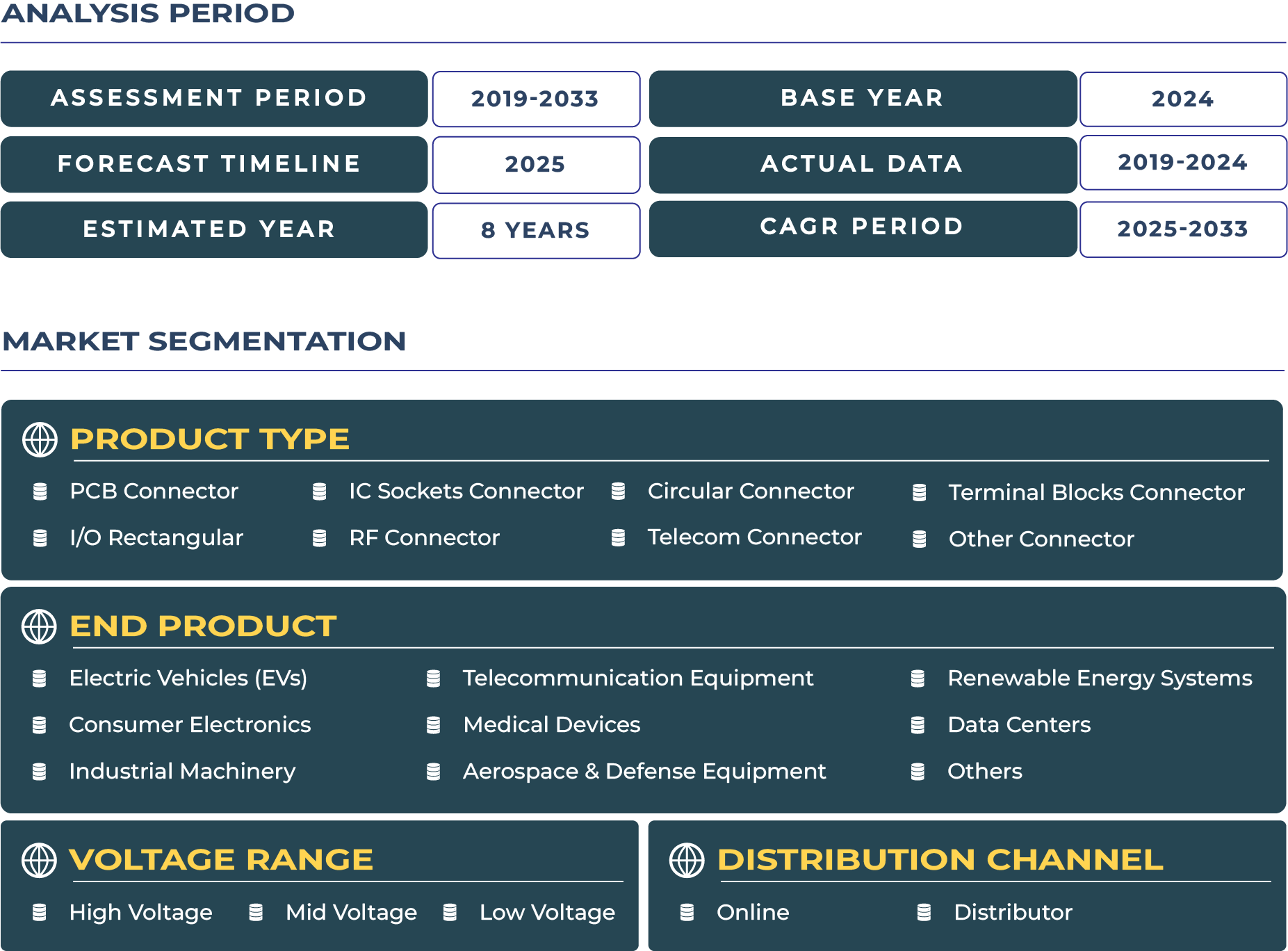Report Format:
![]()
![]() |
Pages: 110+
|
Pages: 110+
Hong Kong Connector Market Outlook
Hong Kong connector market is undergoing a rapid transformation, driven by surging demand from electric vehicles (EVs), data centers, telecom infrastructure, and industrial automation. As per David Gomes, Manager – Semiconductor, the Hong Kong connector market is estimated to cross USD 2.86 billion by 2033, underpinned by cross-sector digitalization, EV policy momentum, and regional technology investments. The market’s evolution is not just about hardware; it's a critical enabler of Hong Kong’s broader infrastructure modernization and its emerging position as a strategic node in the Asia-Pacific innovation corridor.
The growing penetration of electric vehicles across the city is reshaping demand for high-voltage connectors, shielded charging terminals, and compact, ruggedized modules capable of supporting fast charging, high current density, and thermal efficiency. Government initiatives, including first registration tax waivers of up to HK$287,500 under the one-for-one replacement scheme, have fast-tracked EV adoption, with EVs comprising over 60% of new car registrations in 2023. As a result, automotive connector manufacturers are recalibrating their portfolios to meet ISO 26262 functional safety standards and accommodate diverse powertrain architectures. Industry players such as Amphenol, TE Connectivity, and Yazaki are actively partnering with Chinese EV OEMs expanding into Hong Kong, while local manufacturers are innovating around IP67-rated, heat-resistant, and quick-latch connector designs optimized for the region’s subtropical conditions.
Data center investments are another core driver of the connector market. With Hong Kong’s data center industry expected to grow 2times from 2024 to 2033, the need for high-density backplane connectors, fiber-optic interconnects, and power distribution units (PDUs) is escalating. Operators like Equinix, BDx, and GDS are deploying next-generation facilities with liquid-cooled servers and AI-optimized GPUs, requiring advanced connectivity solutions with low latency, EMI shielding, and high bandwidth. As per David Gomes, demand is particularly strong for copper-to-fiber hybrid cabling assemblies and board-to-board connectors used in edge computing and AI inference clusters. The market also benefits from Hong Kong’s stable regulatory environment, robust IP protection, and its proximity to Shenzhen's electronic supply chain.
Hong Kong’s broader digital transformation is equally relevant. As the city expands 5G, smart city, and IoT infrastructure, telecom and industrial connectors are in high demand. Hong Kong’s ambitious plans to achieve citywide 5G coverage and integrate smart traffic, lighting, and surveillance systems are creating a strong pull for M12 connectors, circular connectors, and modular fieldbus interfaces capable of operating in high-vibration outdoor environments. Leading system integrators are sourcing industrial-grade connectors with UL and IEC compliance to ensure uptime, data integrity, and safety. Several local companies have begun to co-develop customized interconnects for robotics, AI-powered CCTV units, and autonomous vehicles tested within the Cyberport and Science Park ecosystems.
The industrial and energy sectors are also emerging growth segments. With Hong Kong committing to increasing its zero-carbon energy imports to 60–70% by 2035 and upgrading systems like the Clean Energy Transmission System (CETS), there is heightened demand for high-voltage, flame-retardant, and UV-resistant connectors suited for energy infrastructure, offshore wind, and nuclear interconnects. These developments are pushing connector manufacturers to engineer high-amperage, corrosion-resistant solutions with crimp-free locking systems, reducing maintenance downtime while enhancing energy resilience. Additionally, as building automation adoption grows, especially in LEED-certified commercial buildings, the use of intelligent sensor connectors and HVAC wire terminals is surging in smart infrastructure projects.
Despite its compact geography, Hong Kong plays an outsized role as a regional trade hub, making it a critical logistics point for connector exports and imports between ASEAN, Mainland China, and global electronics markets. Port enhancements and direct rail links to cities like Xi’an and Wuhan have improved trade throughput, making Hong Kong attractive for connector distributors and warehousing partners looking to scale operations. Financial and trade enablers like the RMB100 billion Trade Financing Liquidity Facility and cross-border payment interoperability further enhance the city’s role as a gateway for high-tech equipment sourcing.
To maintain market competitiveness, manufacturers are investing in automated assembly lines, cleanroom molding environments, and AI-driven defect inspection systems that can ensure batch-level consistency and meet the growing demand for miniaturized, high-frequency connectors. The rise of co-engineering partnerships between OEMs, EMS providers, and connector specialists is fostering innovation, especially for niche applications in aerospace avionics, smart healthcare devices, and marine-grade power connectors. Several Hong Kong-based R&D centers are receiving government-backed grants to localize rare-metal alloy development for next-gen contact plating materials that improve conductivity and lifespan.
In sum, the Hong Kong connector market represents a dynamic intersection of electrification, digitalization, and sustainability. By aligning with EV infrastructure growth, data center scalability, and green energy transition goals, connector manufacturers and suppliers in the region are poised to capitalize on a decade of high-tech infrastructure spending and cross-border technology convergence. Business leaders evaluating this market should consider Hong Kong not just as a demand center, but as a high-value design, testing, and logistics hub for global connector innovation.
Authors: David Gomes (Manager – Semiconductor)
*Research Methodology: This report is based on DataCube’s proprietary 3-stage forecasting model, combining primary research, secondary data triangulation, and expert validation. [Learn more]







